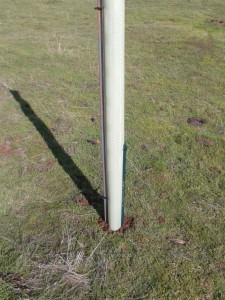I am excited to be working with a group near Springville, CA to re-establish native California oaks on a ranch-turned-natural preserve.
Valley (California white), coast live, and blue oaks are being planted as pre-sprouted acorns. Project managers and – more to the point – the oaks they are planting face many obstacles. These oak acorns will be sprouting into a very different environment that the one in which their parents and ancestors got started.
Nearly all of the grasses they will be competing with for water, nutrients and sunlight are non-native; the oaks didn’t co-evolve with them. One of the oaks’ greatest allies in regeneration – fire – is not available as a management tool. The soil is different – more compacted due to cattle grazing, more eroded, and without the mycorrhizae (beneficial fungi which form a symbiotic relationship with tree roots to improve absorption) they need to peak growth.
These particular oak acorns face another obstacle: cattle. This project is only viable because the landowner leases the grazing rights to neighboring ranchers. But cattle and oak seedlings go together like me and pepperoni pizza – one of us isn’t going to last long and the other is going to get fatter (although I don’t tend to step on pepporoni pizzas – what a waste that would be! – the way cattle often trample oak seedlings).
Tree tubes to the rescue! In Europe tree tubes have long been used to protect trees from livestock in “agroforestry” or “silvopastural” (two fancy words that both mean simply planting trees where livestock are grazing) systems.

Cattle graze a ranch near Springville, CA while 6ft Tree Tubes protect newly planted valley oak, coast live oak, and blue oak acorns.
When using tree tubes to protect planted acorns and seedlings from livestock, the stakes you use are obviously of paramount importance. For this project we discussed and tried several materials before settling on good old steel t-posts. As much as I love PVC stakes we just could drive them into soil this compacted, even after rains that turned the grass winter green (as compared to summer gold).
Cows and sheep love to rub against tree tubes, and often spin them around the stake. I highly recommend using a second, shorter stake – which I call the spin stake – on the opposite side of the tube:

When using tree tubes to protect seedlings from livestock in agroforestry or silvopastoral applications, using two stakes is highly recommended. In this case a 6ft t-post is use for primary support (left side of tube) and a shorter steel stake is used (right side of tube) to prevent cattle from spinning the tube around the stake.
I’m guessing the tubes will be put to the test soon. The first five tubes hadn’t been up for 30 minutes before Bessie – or is that Daisy? – decided to give one a nuzzle and a sniff:

A curious cow nudges a newly installed tree tube – probably the first of many nuzzles, shoves and bites the tree tubes will endure in the coming years. But they have proven time and again they are up to the task.
What a gorgeous site! What an awesome project! I can’t believe I’m lucky enough that it’s my job to help folks with projects like this. Once upon a time these hills were much more densely covered with oaks that provided food for wildlife and humans (yes, humankind ate acorns for millenia and still do in many parts of California).
One project manager told me that the grass that grows under oak trees is much more nutritious than open-grown grass. If the oak canopy is too dense the rate of grass growth is slowed to a point that negates the gains in nutrition. So there is a sweet spot where there is enough oak cover to improve the forage without significantly reduces the growth of the forage.
But in order to find that sweet spot we need to get more oaks going. And to do that we have to protect them from the cattle they will someday benefit.
